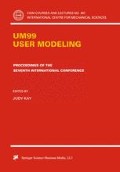Abstract
We describe representation, inference strategies, and control procedures employed in an automated conversation system named the Bayesian Receptionist. The prototype is focused on the domain of dialog about goals typically handled by receptionists at the front desks of buildings on the Microsoft corporate campus. The system employs a set of Bayesian user models to interpret the goals of speakers given evidence gleaned from a natural language parse of their utterances. Beyond linguistic features, the domain models take into consideration contextual evidence, including visual findings. We discuss key principles of conversational actions under uncertainty and the overall architecture of the system, highlighting the use of a hierarchy of Bayesian models at different levels of detail, the use of value of information to control question asking, and application of expected utility to control progression and backtracking in conversation.
We are grateful for assistance provided by Mike Barnett, Herb Clark, and Andy Jacobs.
Access this chapter
Tax calculation will be finalised at checkout
Purchases are for personal use only
Preview
Unable to display preview. Download preview PDF.
References
Albrecht, D.W., Zukerman, I., Nicholson, A.E., Bud, A. (1997). Towards a Bayesian model for keyhole plan recognition in large domains. In Jameson, A, Paris, C., and Tasso, C., eds., Proceedings of the Sixth International Conference on User Modeling. New York: Springer-Verlag. 365–376.
Allen, J.F., and Perrault, C. (1980). Analyzing intention in utterances. Artificial Intelligence 15:143–178.
Clark, H.H. (1983). Making sense of nonce sense. In G.B. Flores d’Arcais and R. Jarvella, eds., The Process of Language Understanding. New York: Wiley. 297–331.
Clark, H.H. (1996). Using Language. Cambridge University Press.
Cohen, P.R., and Levesque, H.J. (1994). Preliminaries to a collaborative model of dialogue. Speech Communication 15:265–274.
Conati, C., Gertner, A.S., VanLehn, K., Druzdzel, M.J. (1997). Online student modeling for coached problem solving using Bayesian networks. In Jameson, A, Paris, C., and Tasso, C., eds., Proceedings of the Sixth International Conference on User Modeling. New York: Springer-Verlag. 231–242.
Gorry, G.A. and Barnett, G.O. (1968). Experience with a model of sequential diagnosis. Computers and Biomedical Research 1:490–507.
Heckerman, D.E., Horvitz, E., and Nathwani, B.N. (1992). Toward normative expert systems: Part I. The Pathfinder project. Methods of Information in Medicine 31:90–105.
Heckerman, D., and Horvitz, E. (1998). Inferring informational goals from free-text queries: A Bayesian approach, Fourteenth Conference on Uncertainty in Artificial Intelligence, San Francisco: Morgan Kaufmann Publishers, 230–237. http://research.microsoft.com/~horvitz/aw.htm/~horvitz/aw.htm
Heidorn, G.(1999) Intelligent writing assistance. In Dale, R., Moisl, H., and Somers, H. eds., A Handbook of Natural Language Processing Techniques. Marcel Dekker.
Horvitz, E. Heckerman, D.E., Ng, K. and Nathwani, B.N. (1989). Heuristic abstraction in the decision-theoretic Pathfinder system, Proceedings of the Thirteenth Symposium on Computer Applications in Medical Care. IEEE Computer Society Press. 178–182.
Horvitz, E., Breese, J., and Henrion, M. (1988). Decision theory in expert systems and artificial intelligence. International Journal of Approximate Reasoning, Special Issue on Uncertainty in Artificial Intelligence 2:247–302. http://research.microsoft.com/~horvitz/dt.htm/~horvitz/dt.htm
Horvitz, E., Barry, M. (1995). Display of information for time-critical decision making. In Besnard, P., and Hanks, S.,. eds., Proceedings of the Eleventh Conference on Uncertainty in Artificial Intelligence. San Francisco: Morgan Kaufmann. 296–305. http://research.microsoft.com/~horvitz/vista.htm/~horvitz/vista.htm
Horvitz, E., Breese, J.S., Heckerman, D., Hovel, D., Rommeise, K. (1998). The Lumiere Project: Bayesian user modeling for inferring the goals and needs of software users, Fourteenth Conference on Uncertainty in Artificial Intelligence. San Francisco: Morgan Kaufmann Publishers. 256–265. http://research.microsoft.com/~horvitz/lumiere.htm/~horvitz/lumiere.htm
Horvitz, E. (1999). Principles of mixed-initiative user interfaces, In Proceedings of Computer-Human Interaction ’99, Association for Computing Machinery Press.
Jameson, A., Schafer, R., Simons, J., and Weis, T. (1995). Adaptive provision of evaluation-oriented information: Tasks and techniques. Proceedings of the Fourteenth International Joint Conference on Artificial Intelligence. 1886–1895.
Jameson, A. (1996) Numerical uncertainty management in user and student modeling: An overview of systems and issues. User Modeling and User-Adapted Interaction 5:193–251.
Jennings, N.R., and Mamdani, E.H. (1992). Using joint responsibility to coordinate collaborative problem solving in dynamic environments. Proceedings of the Tenth National Conference on Artificial Intelligence. Menlo Park: AAAI Press. 269–275.
Levinson, S.C. (1992). Activity types and language. In P. Drew and J. Heritage, eds., Talk at Work. Cambridge University Press. 66–100.
Nunberg, G. (1979). The non-uniqueness of semantic solutions: Polysemy. Linguistics and Philosophy 3:143–184.
Paek, T., and Horvitz, E. (1999), A layered representation of uncertainty for managing dialogue. Manuscript submitted for publication.
Author information
Authors and Affiliations
Editor information
Editors and Affiliations
Rights and permissions
Copyright information
© 1999 Springer Science+Business Media New York
About this paper
Cite this paper
Horvitz, E., Paek, T. (1999). A Computational Architecture for Conversation. In: Kay, J. (eds) UM99 User Modeling. CISM International Centre for Mechanical Sciences, vol 407. Springer, Vienna. https://doi.org/10.1007/978-3-7091-2490-1_20
Download citation
DOI: https://doi.org/10.1007/978-3-7091-2490-1_20
Publisher Name: Springer, Vienna
Print ISBN: 978-3-211-83151-9
Online ISBN: 978-3-7091-2490-1
eBook Packages: Springer Book Archive

